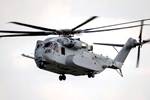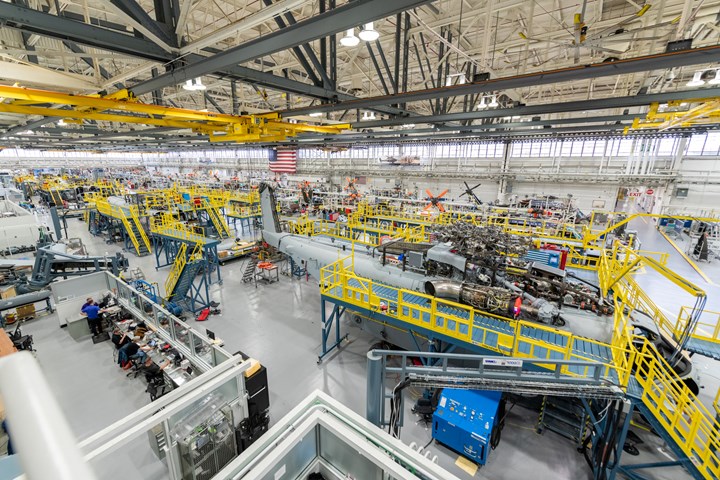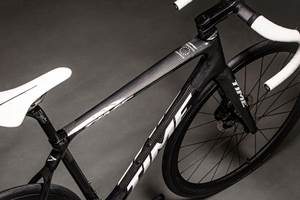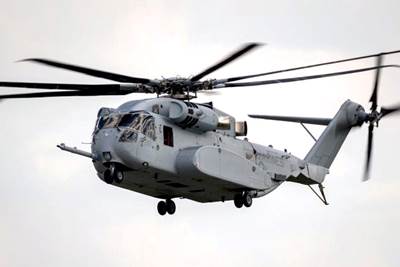Sikorsky delivers third CH-53K helicopter to U.S. Marine Corps
This is the third out of seven composites-intensive heavy-lift helicopters that have been delivered to the fleet exceeding all DOD rotary wing platforms, created in a complete, digital environment.
Sikorsky Aircraft (Stratford, Conn., U.S.), a Lockheed Martin (Bethesda, Md., U.S.) company, has delivered the third low-rate initial production (LRIP) composites-intensive CH-53K helicopter ahead of contract schedule to the U.S. Marine Corps. This aircraft, built in Sikorsky’s digital factory, is reported to be the first CH-53K from the Lot 2 LRIP contract awarded by the U.S. Navy in 2019, and the seventh overall delivered to the fleet. The CH‑53K’s heavy-lift capabilities exceed all other U.S. Department of Defense (DOD) rotary wing platforms and is the only heavy-lift helicopter that will remain in production through 2032 and beyond.
The CH-53K heavy lift helicopter joins the six in operation at Marine Corps Air Station New River in Jacksonville, N.C. The CH-53K is said to be the only sea-based, long-range, heavy-lift helicopter in production and will immediately provide three times the lift capability of its predecessor.
“This Connecticut-built CH-53K aircraft is a credit to our employees and their skills embracing digital tools and other advanced technologies to continue the Sikorsky legacy of building modern, safe, reliable rotorcraft. Our nationwide supply chain supports the active production line as we prepare to deliver two more CH-53K helicopters later this year,” Bill Falk, director, Sikorsky CH-53K program, says. “We look forward to continuing our progress toward next year’s full rate production decision.”
The CH-53K helicopter was born in a digital environment, and now its digital thread connects design, manufacturing, training and sustainment teams. This network, that includes everything from work instructions to maintenance manuals, is based on the helicopter’s single, continuous data thread that stays consistent from initial design all the way through sustainment, according to Sikorsky. Today, all of Sikorsky's aircraft programs are born in a digital environment, driving affordability, producibility and reliability across the aircraft lifecycle.
The CH-53K is Sikorsky’s pioneer digital technology program with advancing installation of wheels, electrical units, hydraulics and more. The high-tech production line in Connecticut is active with seven aircraft in build on final assembly.
The CH-53K helicopters are being built at Sikorsky headquarters in Stratford, Conn., U.S., leveraging the company’s digital build and advanced technology production processes.
The U.S. Marines recently declared Initial Operational Capability (IOC) and have been flying and supporting the CH-53K in the fleet environment demonstrating the aircraft is on track to deploy on schedule in 2024. The aircraft have flown more than 3,000 flight hours showcasing the CH‑53K’s performance in a range of mission scenarios and challenging environments.
The CH-53K will support the U.S. Marine Corps in its mission to conduct expeditionary heavy-lift assault transport of armored vehicles, equipment and personnel to support distributed operations deep inland from a sea-based center of operations, critical in the Indo-Pacific region.
Earlier this year Sikorsky says it also secured a contract to build 12 CH-53K heavy-lift helicopters for Israel under a U.S. Navy Foreign Military Sales (FMS) agreement. The signed letter of offer and acceptance (LOA) between the U.S. government and Israel states first deliveries of the baseline aircraft are planned for 2025.
The CH-53K helicopters will replace the Israeli Air Force (IAF) fleet of modified CH-53D Yasur helicopters, which have been in Israel’s inventory for more than 50 years. The all-new CH-53K reportedly delivers modern state-of-the-art capabilities that result in improved survivability, safety and reduced aircrew workload over its predecessor.
Related Content
Lighter, stronger, faster bionic hand aided by composites design
Psyonic’s touch-sensing prosthetic hand leverages bionic technology, 3D printing and a carbon fiber composite exterior for light weight, high strength and high-tech functionality.
Read MoreTime Bicycles to modernize composite bicycle manufacturing
With the aid of KraussMaffei, Clemson University and SC Fraunhofer USA Alliance, Time anticipates a transition to HP-RTM for more efficient carbon fiber bike frame manufacture, plus a new facility in South Carolina.
Read MorePlant tour: Arris Composites, Berkeley, Calif., U.S.
The creator of Additive Molding is leveraging automation and thermoplastics to provide high-volume, high-quality, sustainable composites manufacturing services.
Read MoreRunning shoe insoles get a lift with thermoplastic fiberglass tapes
FlexSpring insoles take advantage of unidirectional, continuous fiberglass and thermoplastics to enable next-level performance for the everyday runner.
Read MoreRead Next
Albany Engineered Composites wins ten-year contract for CH-53K helicopter assemblies
Selected by Lockheed-Sikorsky, AEC will leverage its composites expertise in engine and airframe applications to meet a 2023 delivery period.
Read More“Structured air” TPS safeguards composite structures
Powered by an 85% air/15% pure polyimide aerogel, Blueshift’s novel material system protects structures during transient thermal events from -200°C to beyond 2400°C for rockets, battery boxes and more.
Read MorePlant tour: Daher Shap’in TechCenter and composites production plant, Saint-Aignan-de-Grandlieu, France
Co-located R&D and production advance OOA thermosets, thermoplastics, welding, recycling and digital technologies for faster processing and certification of lighter, more sustainable composites.
Read More


























